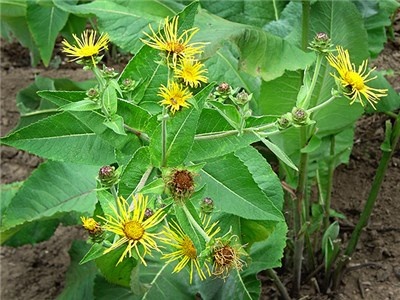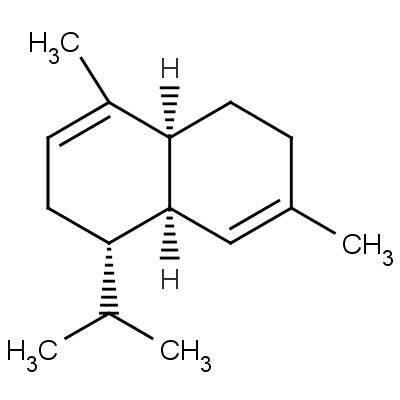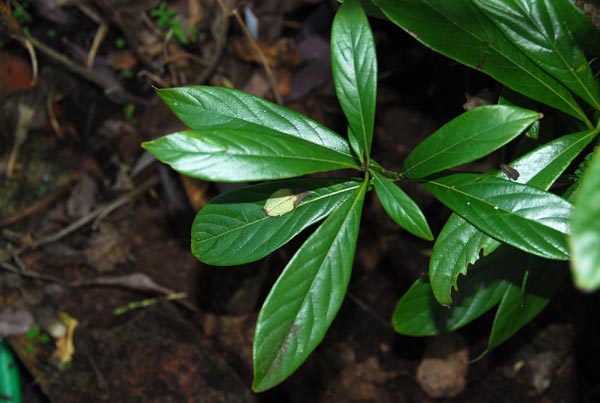Alpha-muurolene, or α-muurolene, is part of the cadinene sesquiterpenoid family. Sesquiterpenoids are terpenes with three consecutive isoprene units. Cadinenes are bicyclic sesquiterpenoids. Notably, cadinenes have demonstrated some antifungal properties and potential as natural fungicides. [1]
Image Credits: CAS
Alpha-muurolene has been found in cinnamon and Inula helenium (horse-heal, see header image) root extracts, the latter of which have antioxidant properties, so perhaps further studies will discover something promising in that regard. [2] The concentration of α-muurolene and its oxidation products have been observed during the wet and dry seasons in central Amazonia, with mean concentrations of 1.50 nanograms per cubic meter (ng/m3) and 1.45 ng/m3, respectively. [3]
Alpha-muurolene is a central component in the essential oil from wood of Phoebe bournei (Yang, pictured below) at 7.32%. This wood has demonstrated some antitumor, antibacterial, and hypoglycemic properties, so the terpene’s relatively significant presence is promising. [4] Alpha-muurolene has been detected in essential oils from Hyptis monticola, a wild Brazilian plant species from high altitude with some antibacterial and antifungal properties, accounting for 6.4% of its contents. [5]
Phoebe bournei Image Credit: Earth.com
Furthermore, the terpene turned out to be one of the most abundant constituents of air-dried and conventionally dried Cryptomeria japonica (Japanese cedar) wood, which is a clear indicator of the nature of its aroma and aligns with the prevailing wisdom that α-muurolene’s scent is woody with hints of pine and citrus. [6]
Alpha-muurolene even showed up in Moutai, a Chinese liquor, along with quite a few other terpenes. [7] Considering the aromatic connotations that drinks from the far East tend to conjure, we might see our terpene in question in other fragrant concoctions of various natures.
For now, α-muurolene remains mostly a rich-smelling mystery that makes episodic appearances in a wide variety of places that reveal glimpses of its potential. Hopefully, we’ll see more of it in the future.
References:
- Kundu, et al. “Cadinene Sesquiterpenes from Eupatorium adenophorumand Their Antifungal Activity.” Journal of Environmental Science and Health B, vol.48, no.6, 2013, pp. 516-522. Journal Impact Factor = 1.463; Times Cited = 39
- Spiridon, et al. “Antioxidant and Chemical Properties of Inula helenium Root Extracts.” Open Chemistry, vol. 11, no. 10, 2013. Journal Impact Factor = 1.512; Times Cited = 20
- Yee, et al. “Observations of Sesquiterpenes and Their Oxidation Products in Central Amazonia During the Wet and Dry Seasons.” Chem. Phys., vol. 18, no.14, pp. 10433–10457, 2018. Journal Impact Factor = 5.668; Times Cited = 11
- Ning, et al. “Essential Oil Extracted from Wood of Phoebe bournei (Hemsl.) Yang: Chemical Constituents, Antitumor, Antibacterial, and Hypoglycemic Activities.” , vol.14, no.1, pp. 858-869. Journal Impact Factor = 5.807; Times Cited = 1
- Wilmer, et al. “Essential Oil Constituents from High Altitude Brazilian Species with Antimicrobial Activity: Baccharis parvidentata Malag., Hyptis monticola ex Benth. and Lippia origanoides Kunth.” Journal of Essential Oil Research, vol.29, no.2, 2017, pp. 109-116. Journal Rank = 0.367; Times Cited = 9
- Ohira, et al. “Evaluation of Dried-wood Odors: Comparison Between Analytical and Sensory Data on Odors from Dried sugi (Cryptomeria japonica) ” Journal of Wood Science, vol. 55, no.2, 2009, pp 144–148. Journal Impact Factor = 1.523; Times Cited = 19
- Wang, et al. “Identification and Aroma Impact of Volatile Terpenes in Moutai Liquor.” International Journal of Food Properties, vol. 19, no.6, 2016, pp.1335-1352. Journal Impact Factor = 1.398; Times Cited = 11
Horse-Heal Header Image Credit: Rare Seeds










